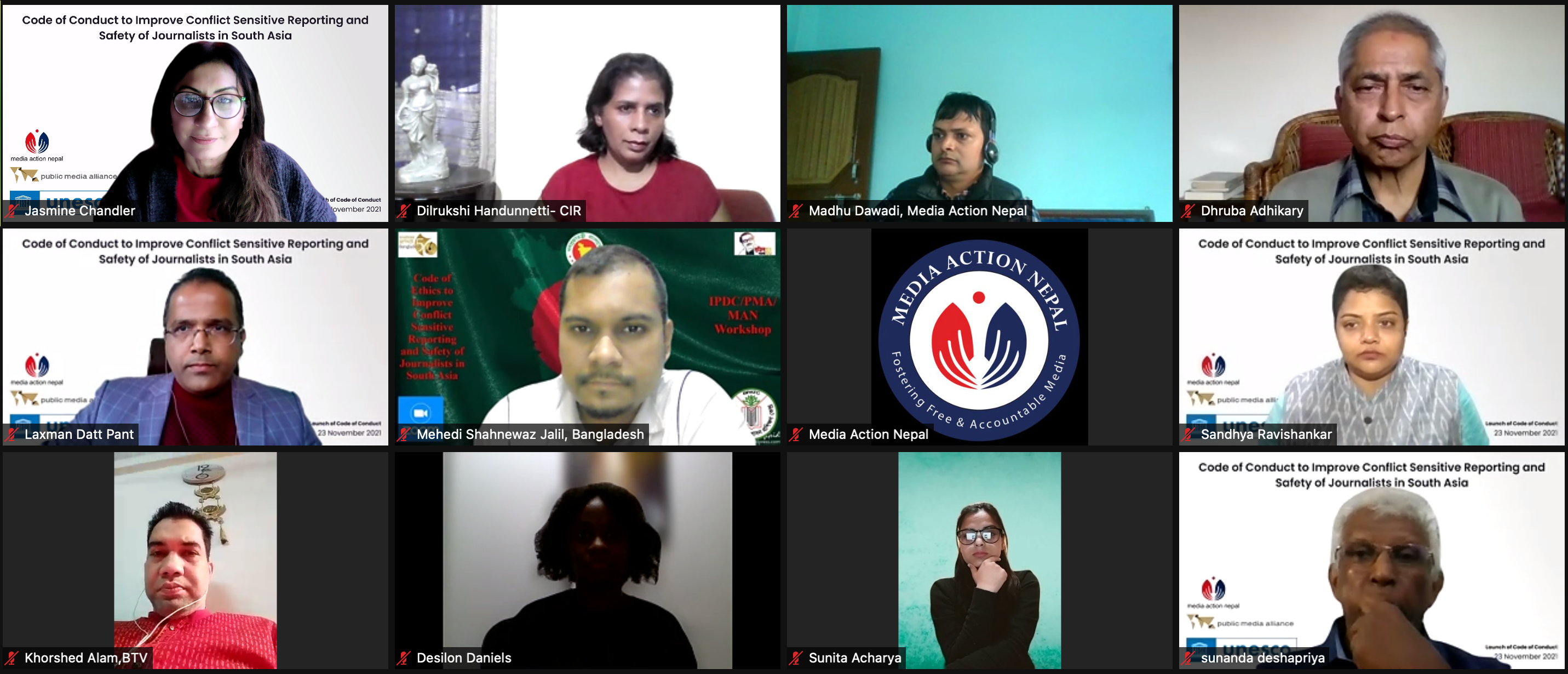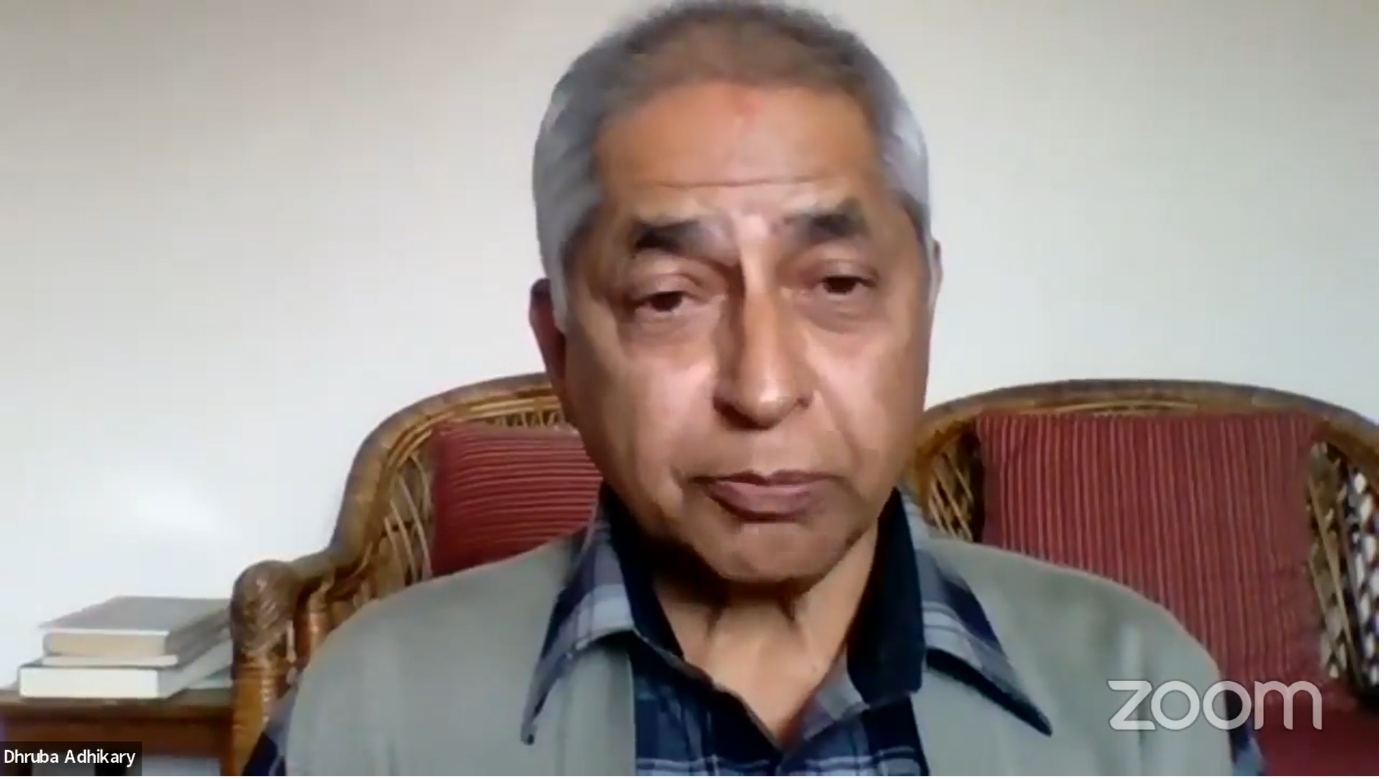KEYNOTE ADDRESS
The importance of ethics when reporting on conflict
Mr. Dhruba Hari Adhikary is an Advisor at Media Action Nepal and a senior journalist who has been in the media field since 1979. He was the keynote speaker at the launch of the Code of Conduct on Improving Conflict Sensitive Reporting & Journalist Safety in South Asia, held virtually on Tuesday 23 November 2021.

“The importance of ethics when reporting on conflict: a regional outline of the issues and key challenges”
Warm Greetings from Kathmandu to all the participants of the programme!
Let me begin by thanking the organisers who have diligently worked to complete this project on behalf of Public Media Alliance, in collaboration with Media Action Nepal, and UNESCO.
Your collective efforts and inputs including those derived from a three-day workshop participated by media workers from Bangladesh, India, Nepal, and Sri Lanka have enabled us today to launch a Code of Conduct that aims at strengthening the media environment in South Asia, in terms of conflict-sensitive reporting, journalists’ safety and self-regulation.
Thanks also for extending to me this privilege to be the Keynote Speaker of this important event. And I intend to utilize this opportunity to share some of my thoughts on the necessity of guidelines for journalists covering conflicts of varying nature and intensity.
Meanwhile, selection of South Asia for this purpose appears appropriate because it happens to be one of the most populous regions in the world, and is also known for vast ethnic, cultural, and linguistic diversity. Understandably, the media landscape in the region too has also to be a diverse one.
Read more: Code of Conduct: “Truly distinct” and “absolutely necessary”
Way back in the early 1980s, I was participating in a journalism workshop in Kathmandu which was organized by the Nepal Press Institute. One of the resource persons there, a US national, had earlier worked for the Associated Press (AP) as a photojournalist. He said he was one of those journalists assigned to cover the Korean War (1950-53) from the frontline. At the Kathmandu workshop, he narrated his experience in a lively manner: “There were plenty of actions around me for the coverage; but the first thing I needed to do was to remain alive!
Needless to emphasise, the importance of the safety of journalists is vital. While the advancement of information technology has markedly eased the job of the present generation of journalists, there still remain considerable tasks which require scribes to be physically on the ground: for interviewing victims and identifying perpetrators. Once in the field, journalists have to meet people with competing ideas and conflicting claims.

First, the reporters have to evaluate the ground reality, collect, and sift information and then send stories as well as audio-visuals meant for the audiences who obviously are anything but homogenous.
As a rule, the reporters are expected to be careful and must avoid inserting their personal opinions or perceptions in the news stories they prepare for publication or broadcast. There are separate – and clearly demarcated – platforms, columns, and pages for their opinions and comments. Together with members of the audience, they can, from time to time, also appear in additional platforms such as Facebook and Twitter.
Incidentally, the size of the audience is getting expanded beyond national and regional boundaries. In fact, the contents of almost all media outlets today have a global reach, attracting the attention of steadily increasing diasporas abroad. Neither reporters nor their editors at the newsroom can afford to underestimate the intelligence of present-day audiences who are scattered across the world.
“The ultimate objective of taking initiative to develop the present code of conduct is to assure audiences about the CREDIBILITY of the media as an institution. This is absolutely necessary to prevent erosion of public trust we all have collectively enjoyed thus far.”
Now-a-days, most of the viewers, listeners and readers have the ability to figure out whether or not a particular reporter’s coverage has been accurate, impartial, and responsible. In other words, journalists are expected to allow facts – the verified – to speak for themselves. All they can add are a few words to explain the context and background to stories.
The role of editors is more crucial. Since they are essentially gatekeepers, they need to be extremely careful about the possible use and misuse of emotive or provocative words, for the sake of ensuring accuracy and impartiality. Internal oversight mechanisms such as the reviews of the Ombudsman could be a handy tool for editors.
Here again, I recall having met a journalism teacher, Ross Howard from Canada, in the year 2003. He held a firm view that while professional journalists would not set out to reduce conflict, their accurate and impartial reporting can render considerable help to lessen the level of conflict and its potential consequences.
Now, let me briefly switch over to one more relevant subject. We all are familiar with some of the inherent contradictions in our unique vocation called journalism.
For example, teachers, trainers. and mentors of conventional journalism keep telling their pupils and trainees that usual sights, routine affairs, or mundane happenings do not make news. Something has to be unusual, extraordinary, or unprecedented to be classified as news. This concept of journalism of exception leads us to a point where we are unwittingly persuaded to believe that communities or countries living in harmony have no news value! This belief essentially suggests that journalists are required to look for troubles and troubled spots.
However, this is not a desirable situation. Perhaps a time has come when the conventional definition of news has to be given a second look.
Finally, as each one of us attending today’s programme is aware, the ultimate objective of taking initiative to develop the present code of conduct is to assure audiences about the CREDIBILITY of the media as an institution. This is absolutely necessary to prevent erosion of public trust we all have collectively enjoyed thus far.
I hope today’s event encourages us all to continue to work for preservation of traditionally acquired ‘power of the press’ which is essential for a sustained democratic order.
I thank you all for your kind attention.
Header Image: A press photojournalist is holding a camera with a zoom lens and is photographing war and conflict. Credit: chameleonseye/iStock
Related Posts
29th November 2021
Code of Conduct: “Truly distinct” and “absolutely necessary”
The newly-launched Code of Conduct was…
23rd November 2021
Code of Conduct: Improving conflict sensitive reporting & journalist safety in South Asia
Our Code of Conduct to Improve Conflict…
16th November 2021
Event: Launch of Code of Conduct for conflict sensitive reporting in South Asia
Join us for the launch of our Code of…
10th November 2021
Project update: South Asia conflict sensitive reporting project nears completion
Our South Asia conflict reporting and…

